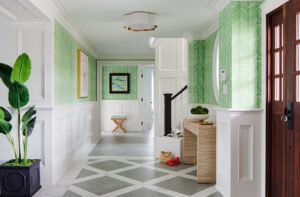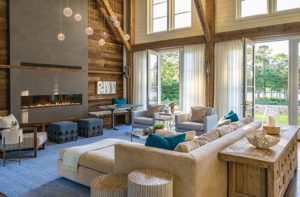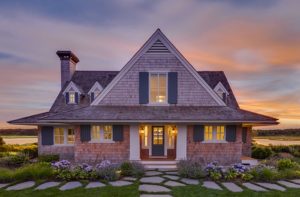On a Historical Note
November 20, 2017
Thanks to a designer’s practiced eye and deft hand, the interiors of an opulent nineteenth-century Back Bay home sing again.
Text by Debra Judge Silber Photography by Greg Premru Produced by Karin Lidbeck Brent
Any home built more than a century ago is likely to have a rich backstory, but the previous life of this stately Back Bay townhouse was more impressive than most. Designed by architects Arthur Rotch and George Thomas Tilden circa 1883 for the family of a prominent Boston businessman, the home—and specifically, its opulent music salon—was the original venue of a well-known classical concert series.
The music room was just one of the features that attracted the twenty-first-century biotech entrepreneur and his wife to the old brick townhouse several years ago. Despite its conversion over the years to a school, offices, and back to a residence, the structure had been well maintained. Its main floor, in particular, retained exquisite nineteenth-century plaster and wood detailing. There was a garden in the back, parking underneath, and 13,000 square feet of space on four floors—plenty of room, even for a family of seven.
Nonetheless, “You needed a lot of imagination to see what it could become,” the homeowner recalls. While she loved the home’s period character, she says, she had no desire to live in a museum. “We were looking for a graceful balance between the old bones of the house and a more contemporary vibe that matches our aesthetic.”
Remodeling a historic treasure to meet the needs of a modern family might seem daunting, but not to The Holland Companies, who were called in for the remodel. “Jobs like this are what we do every day,” says project manager Timothy McGowan.
In this case, the job would involve a different approach on each of the home’s five levels. Only minor updates were needed on the lower level, which opened to the garden and included a large kitchen, nanny’s quarters, and parking area. The ground floor above it would remain largely unchanged structurally, but its wealth of period details demanded meticulous attention. Rooms on the second and third floors—including the master suite and family bedrooms—had to be reconfigured to meet the family’s needs. On the fourth floor, significant structural work was required to transform the boxed-up space into one that the whole family could enjoy together.
Carolina Tress-Balsbaugh, senior designer and partner with Manuel de Santaren, remembers the impression she got the first time she stepped through the front door. “I thought, my God—I feel like I’m in an old bank,” she says. The luxurious mahogany woodwork, marble floors, and elaborate plaster moldings that surrounded her were beautiful, but not, well, residential. Her first instinct: lighten it up.
Taking a cue from the gracious Parisian apartments of designers like Valentino Garavani, Tress-Balsbaugh worked to balance the home’s Old-World embellishments with the crisp, transitional style furniture favored by her client. Applying paint as an editor might wield Wite-Out, Tress-Balsbaugh gave the dark woodwork of the entryway and foyer the light, feathery appearance of frosting on a cake. “It was a bit scary to do this,” she admits. “But when we finished it was just so perfect. It looked beautiful.”
The music room—a special space for this music-loving family—was particularly elaborate. With intricate plasterwork, marble columns, an ornate coffered ceiling, and art glass windows, it barely needed furniture to make a statement. The blue and gold paint on the walls and the angels and clouds on the ceiling were, however, overwhelming. “The molding is so beautiful, all the detail is there,” Tress-Balsbaugh says. “Why gild the lily?”
She toned down the room’s colors to three shades: white, pale gray, and light blue. To warm the space, she replaced the marble floor with oak stained espresso brown and laid in a herringbone pattern. She then introduced transitional pieces—including a duet of Gérard shelter-arm sofas and a quartet of barrel chairs by Christian Liaigre—that are easily slid aside for the occasional family concert. Two grand pianos, one a family heirloom, flank the fireplace at the far end of the room.
The designer applied the same firm but respectful approach throughout the main floor. The living room’s riot of plasterwork on the walls and ceiling is subdued under three shades of white paint. Various lusters—matte, satin, and flat—enhance the slight variations in tone. Ebonized doors and dark wood floors anchor the room, as do furnishings—including a console designed by Tress-Balsbaugh and an angular coffee table from Christian Liaigre—that juxtapose dark against light.
A similar give-and-take between light and dark occurs in the library, where Tress-Balsbaugh painted the dark ceiling white and called in Wayne Towle, a specialist in wood finishing and restoration, to ebonize the surrounding woodwork. A geometric cowhide carpet and a Sputnik lighting fixture relax the atmosphere considerably.
Traditional and contemporary elements mix in the ornate oval dining room, where Tress–Balsbaugh encircled a crystal chandelier with a sheer shade by Blanche Field. It lights a fifteen-foot-long dining table, designed by Tress–Balsbaugh, that features a walnut base and Caesarstone top. “She kind of pushed me on that,” says the client, who feared the table would appear heavy and cold. Instead, it turned out perfect. “It’s one of my favorite pieces of furniture,” she says.
Balsbaugh completely rewrote the score on the second floor. With the help of assistant Shelly -Pascucci, she reconfigured the space to create a master suite with a luxurious bath, an exercise room, a sitting room/office, and his-and-her closets. Nearly the size of the bedroom, the wife’s closet features an island filled with storage drawers and topped with Turkish Carrara marble, as well as a storage wall equipped with a library ladder for reaching the highest shelves.
The same contemporary vibe takes shape in the reconfigured fourth-floor family space. Here, Tress-Balsbaugh knocked down walls and added skylights to create a bright, open area where the family could gather to eat or to relax in front of the recessed widescreen TV. A sleek, functional kitchen features Arclinea cabinetry through Casa Design Living in Boston and incorporates a motorized dining surface that rises to counter height for casual gatherings.
A few steps away, doors lead to a roof deck designed by landscape architect Jacalyn Gould. Built on two levels, the deck offers both a dining area and comfortable seating around a gas fire table. Boxwood hedging and sculptural urns complement the building’s traditional brownstone balustrade, but recede from view without competing with the expansive views of the city. And here, just as inside the house, the furnishings are right at home with the splendor that surrounds them.
Project Team Interior design: Carolina Tress-Balsbaugh, Manuel de Santaren
Builder: The Holland Companies
Landscape design: Jacalyn Gould Landscape Architect
Share
![NEH-Logo_Black[1] NEH-Logo_Black[1]](https://www.nehomemag.com/wp-content/uploads/2022/08/NEH-Logo_Black1-300x162.jpg)
























You must be logged in to post a comment.